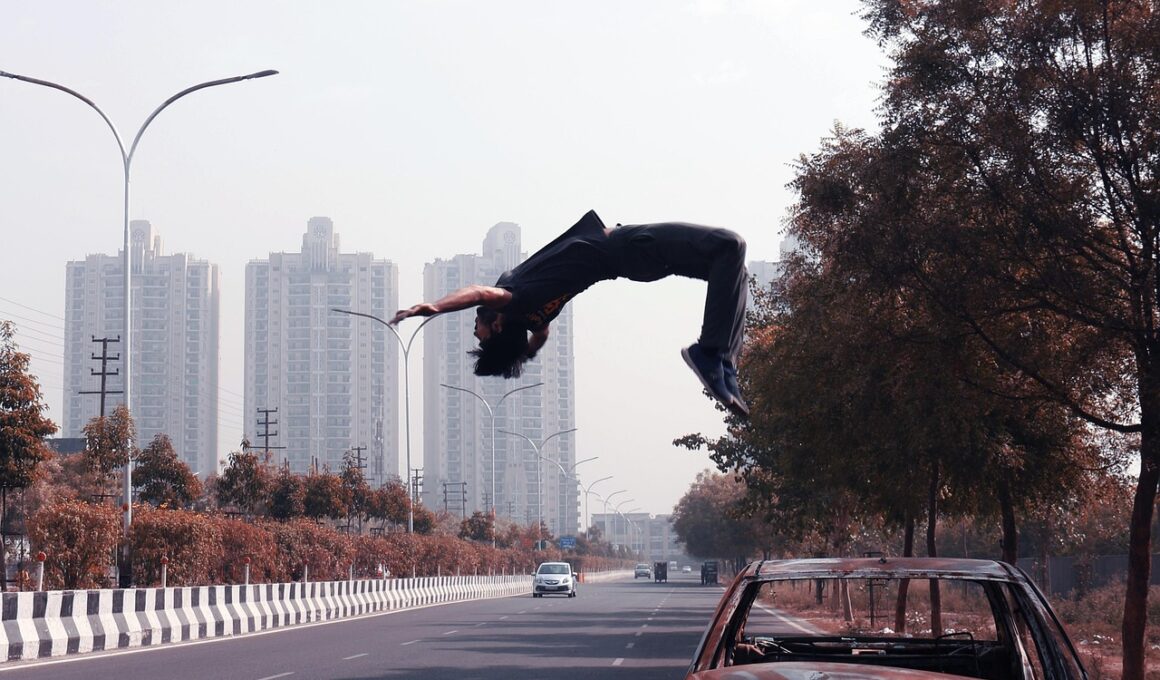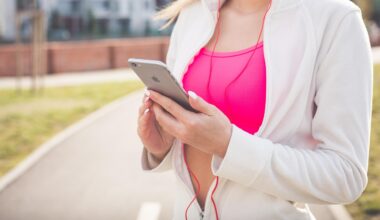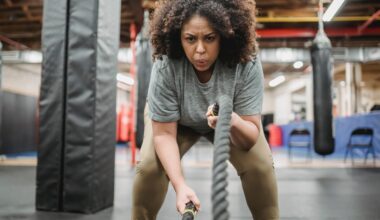Tips for Photographing Parkour in Different Weather Conditions
Capturing parkour in various weather conditions presents unique challenges and opportunities. First, consider how lighting and reflections change with overcast skies or bright sunlight, influencing the overall mood of your shots. Use natural light to your advantage, aiming for golden hour for warmer tones. When shooting during harsh sunlight, experiment with angles to reduce harsh shadows and capture dynamic movements more effectively. Bring gear that protects against rain or moisture, and use weather-sealed camera bodies if possible. Always have a lens cloth handy to keep your lenses clean from sudden rain. A wider aperture can help in low light conditions, emphasizing the motion and creating an ethereal backdrop. For snowy environments, adjust your camera settings to avoid underexposure, as snow can trick your camera’s metering system. Finally, always check for safety when setting up shots, ensuring that both the athlete and the photographer are safe, especially in slick or icy conditions. With the proper techniques, you can create striking images that highlight the artistry of parkour through rain, snow, and sunshine.
In rainy conditions, parkour photography can lead to stunning shots that convey movement and emotion. Utilize puddles to create reflections, enhancing composition significantly. Position yourself strategically to capture jumps that lead into or out of reflections. Embrace the moody atmosphere that rain can provide; it adds a dramatic flair to the subjects and action. Adjust your camera settings for lower light conditions that often accompany rainy weather—make sure to increase your ISO to maintain image quality. This adjustment allows the shutter speed to remain fast enough to capture the fluidity of the movements. Use a fast lens, ideally with a wide aperture, to help in low-light scenarios while also blurring background elements effectively. Consider using flash to freeze the action and illuminate your subject against a dim background. During light rain, waterproof covers can protect your gear without sacrificing the opportunity of capturing incredible moments. Bear in mind that safety comes first; ensure the parkour performer has safe landing spaces even on slippery surfaces. One great option is to shoot from elevated positions, allowing for clean backgrounds and reducing the risk of crashing!
When taking photos in bright sunny weather, understanding how to manage light is crucial. Bright sunlight can create hard shadows that might obscure movements or expressions on the parkour artist’s face. To mitigate this, shoot during the golden hour, just after sunrise or just before sunset. The soft light during these times allows for more balanced exposures and beautiful highlights. If shooting during midday, consider using a polarizing filter to reduce glare and enhance colors. Compositionally, utilizing natural elements like trees and buildings can help create shade and define your subject. Experiment with backlighting to give your shots a dramatic edge; silhouettes can be especially powerful. Remember that wide-angle lenses can help include the environment, enhancing the sense of scale and action. Try not to overwhelm the viewer with too much brightness; lateral angles can share textures and movements without overpowering visuals. Remember to stay hydrated and protect your gear from overheating when working in the sun. Communicate with the parkour athlete to ensure they showcase movements that exploit light and space creatively, highlighting their skills against the backdrop.
Winter Wonder Parkour Photography
Winter photography adds a unique touch when capturing parkour, with snow creating a stunning, crisp canvas. When the ground is covered with snow, ensure to adjust your camera settings for the brightness. Snow can trick your camera’s sensor into underexposing; increase exposure compensation to counter this. To retain detail in highlights, maintain a balance between shutter speed and aperture when shooting quick movements. If using a flash, this can emphasize the texture of snowflakes falling, enhancing your wintery shots. Warm clothing is essential for both the photographer and the athlete to assure comfort during long sessions outdoors. Wide-angle lenses can capture sweeping landscapes, showcasing parkour movements against sweeping terrains. Make use of layers in your imagery; an athlete jumping against snow can create dynamic, powerful compositions. Consider experimenting with burst mode to seize peak action moments— this captures the athlete mid-jump perfectly against the snowy backdrop. Lastly, consider the safety and prepared obstacle course the athlete will use, as hidden dangers like ice may lurk beneath a blanket of snow.
Strong winds can also prove to be challenging during parkour photography sessions, especially near cliffs or open spaces. Understanding the impact of weather on stability is key to snapping clear, focused images. Work with your subject to adjust their movements depending on wind conditions; knowing when to jump, grab or hang can create magical moments only achievable in windy weather. Isolate your subjects from the background wind action by incorporating natural barriers, or shoot at angles that minimize the effect of the wind. Use fast shutter speeds to freeze both the athlete’s movements and the wind-blown elements, ensuring clarity amidst chaos. In high winds, communicate closely with the performer to ensure their safety and comfort. It’s crucial to know how the wind can affect a jump, which helps create safer landing spaces. Understand that the emotional engagement in windy conditions is heightened; embrace the rawness of the moment. Incorporating movement and emotion can lead to fantastic candid shots that display both the athlete’s prowess and the elements at play.
Planning for Inclement Weather
When planning a photo shoot in potential rain or stormy weather, it’s essential to bring the right gear. Weather-sealed cameras and lenses can dramatically improve your capability, allowing you to shoot in conditions that may deter other photographers. Pack an umbrella, or even better, a large circular reflector to provide additional coverage. Scout your locations ahead of time to identify spots that provide shelter and interesting backdrops for your shots. If the area offers sheltered spaces, consider including reflections or bouncing light off wet surfaces, leading to eye-catching results. Discuss with your athlete the best way to utilize these conditions creatively; together, you can create a cohesive plan that turns the weather into an advantage. Use this time to enhance your skills of shooting in adverse conditions, gradually getting accustomed to rain and lighting variances. Always have a secondary lens, or backup memory cards handy, ensuring you can keep capturing while fighting against the weather. Being prepared means you’ll be able to focus more on the creative side of photography when it counts. Take your time to evolve techniques; each weather type offers something unique.
Lastly, the diversity in parkour photography across all weather conditions is what makes this art form exciting. Each condition contributes its own set of challenges and aesthetic opportunities for photographers. Craft and refine your technical skills, understanding how temperatures and elements can change the visual outcome; mastery requires patience and practice. Harness the power of photography to convey narratives that transcend environments while capturing the essence of movement and grace. Keep learning, growing, and experimenting with new techniques as you explore the varying influences of weather on your work. Familiarize yourself with your equipment in distinct environments, emphasizing the importance of flexibility in approach. As you adapt, staying enthusiastic about each shoot leads to a deeper appreciation for parkour and photography. Use the joy of practice to fuel your creativity, leading to standout shots that resonate with viewers. Challenge yourself to push the boundaries, turning everyday shoots into artistic endeavors that tell profound stories of athleticism and environment. Remember, every weather condition has powerful stories waiting to be captured through the lens; it’s up to you to explore!
Utilizing digital tools can significantly enhance your workflow, helping organize your environmental photo shoots with ease. Software such as Lightroom or Photoshop can enable adjustments to contrast and color balance after the session, ensuring your captures shine in their best light. Pre-planning and even scheduling photo shoots according to weather forecasts are essential for maximizing efficiency throughout the entire process. Documenting your experiences, including the weather impacts on each shoot, will help refine your approach and planning in future sessions. Building a portfolio that demonstrates your adaptability in various conditions can widen your exposure and put your skills on display. Engaging with the parkour community through forums or social media showcases your evolving portfolio while connecting with like-minded individuals. Finding inspiration from fellow photographers will help diversify your own style; enhance learning by participating in workshops that emphasize shooting in challenging environments. Experimenting with new styles, incorporating different weather elements, can redefine your approach to parkour photography. Lastly, share your experiences with others, allowing for a collective learning experience that pushes the boundaries of creativity and skill within this growing field.


